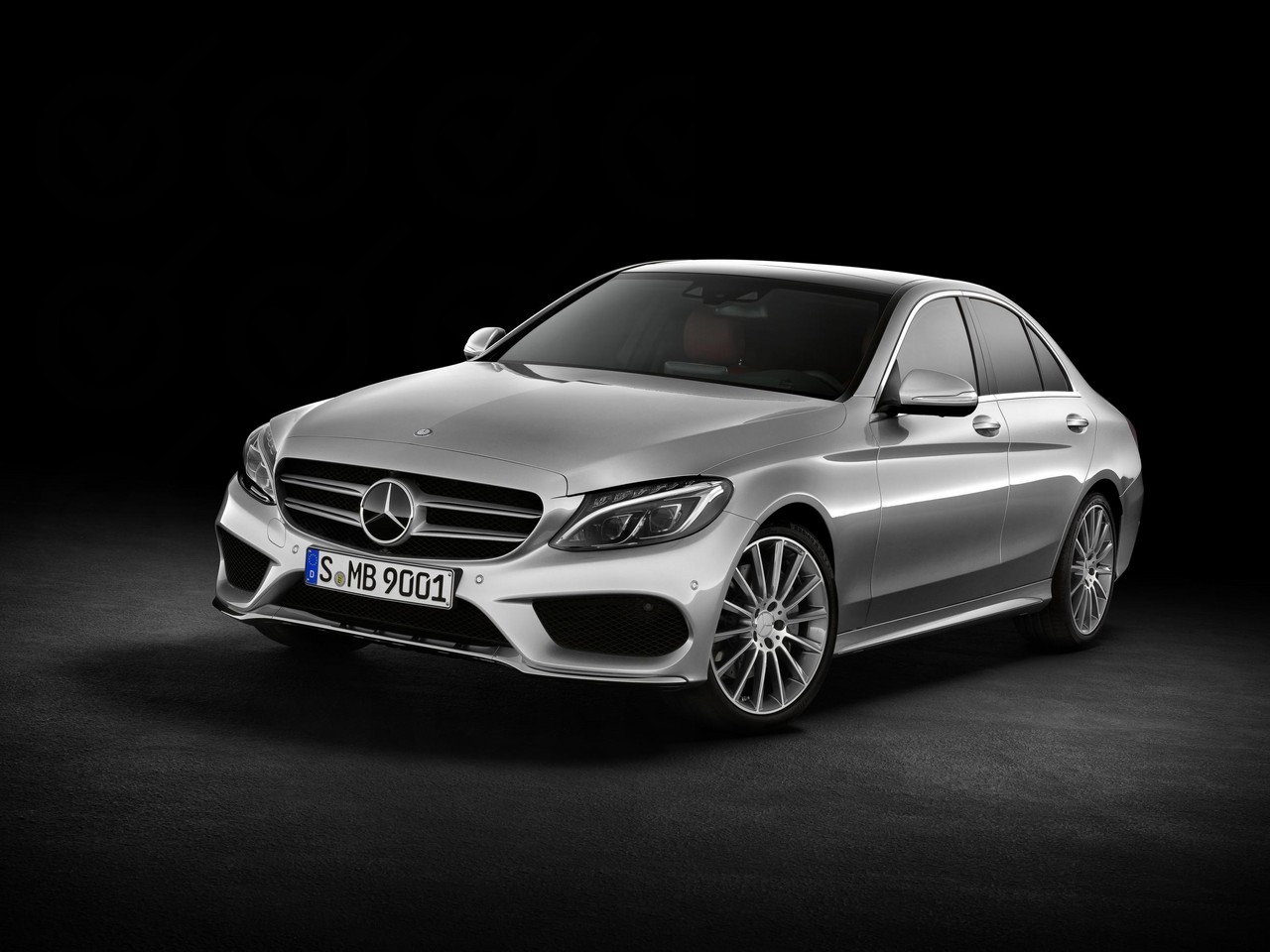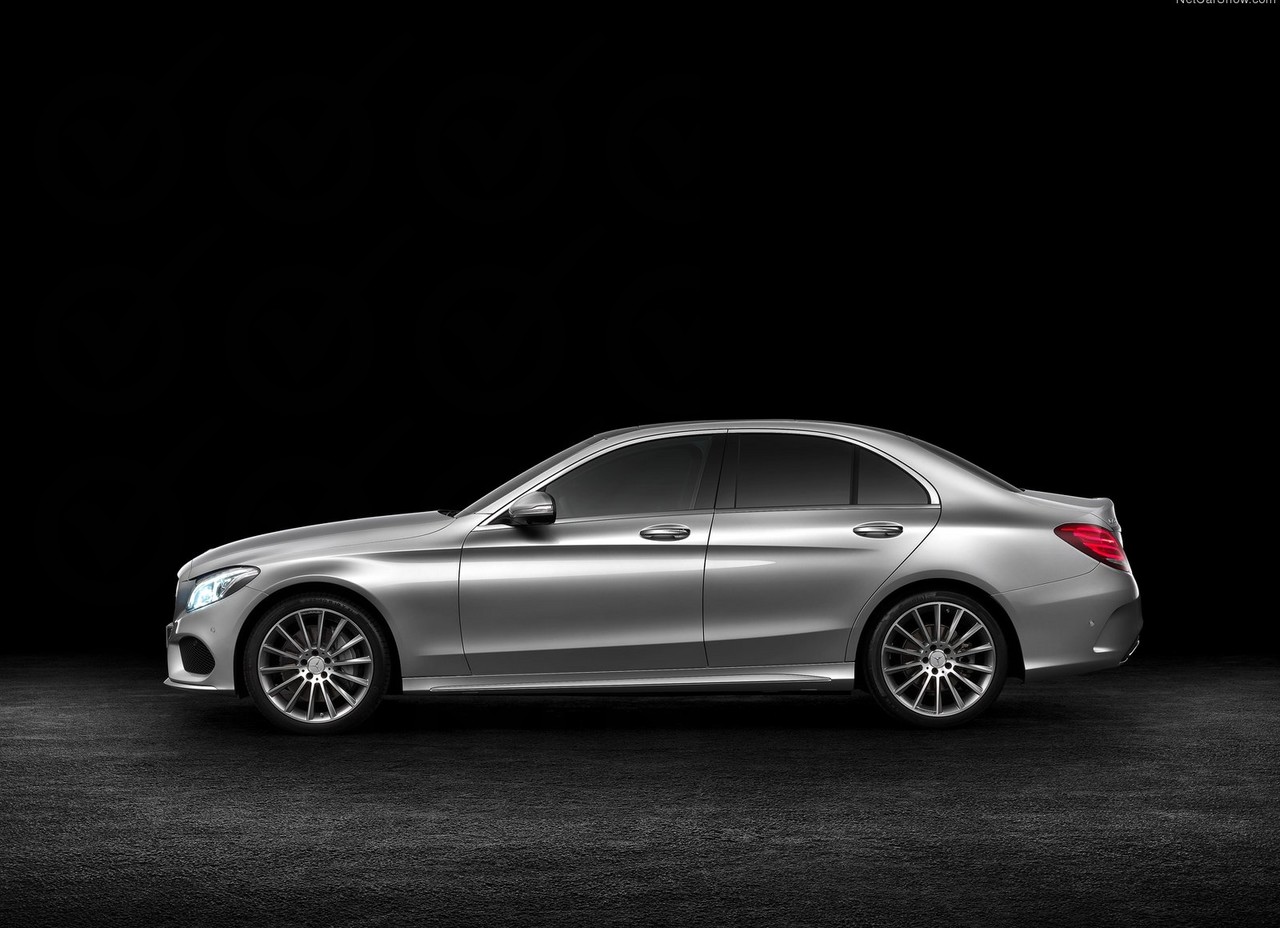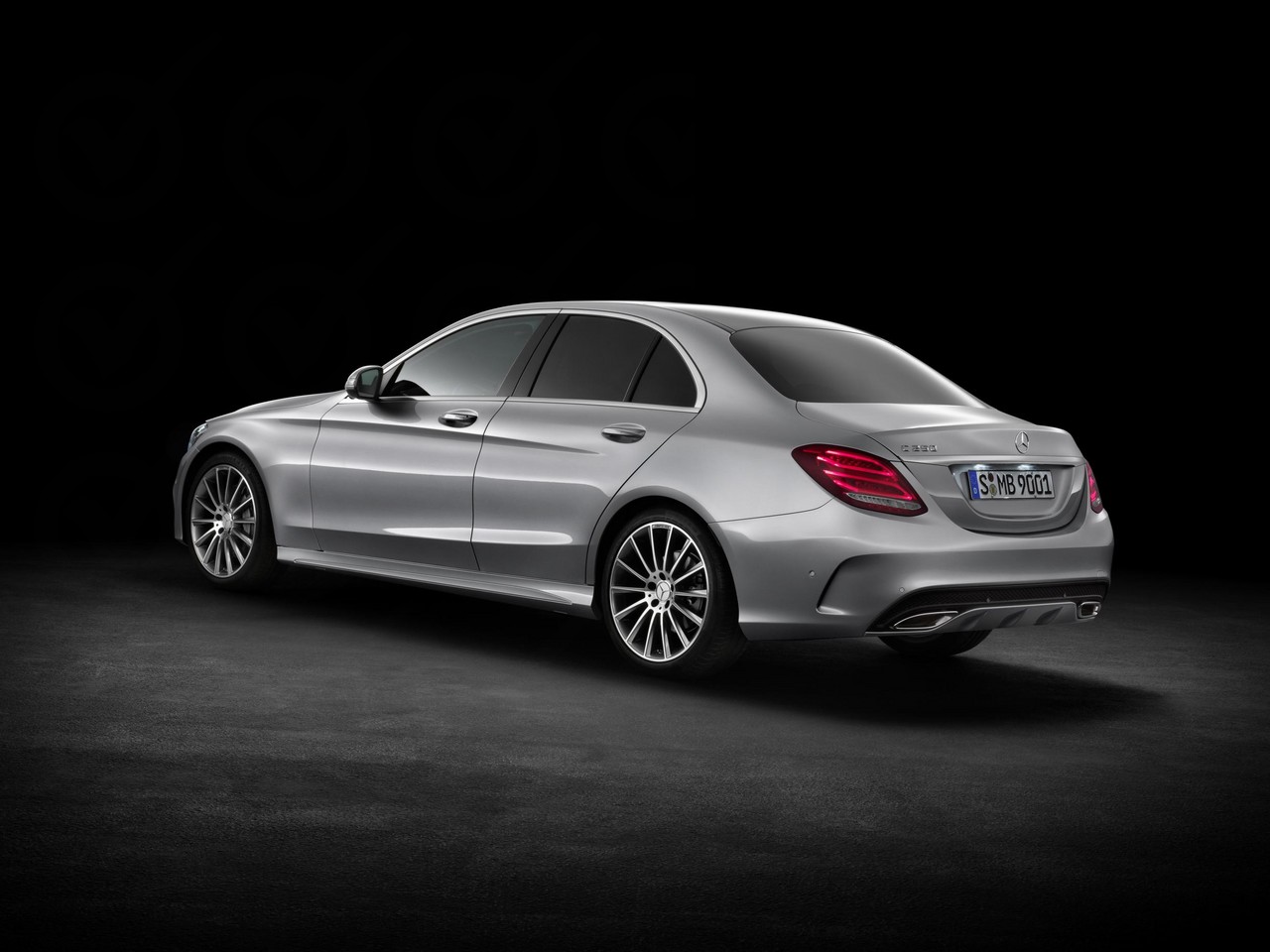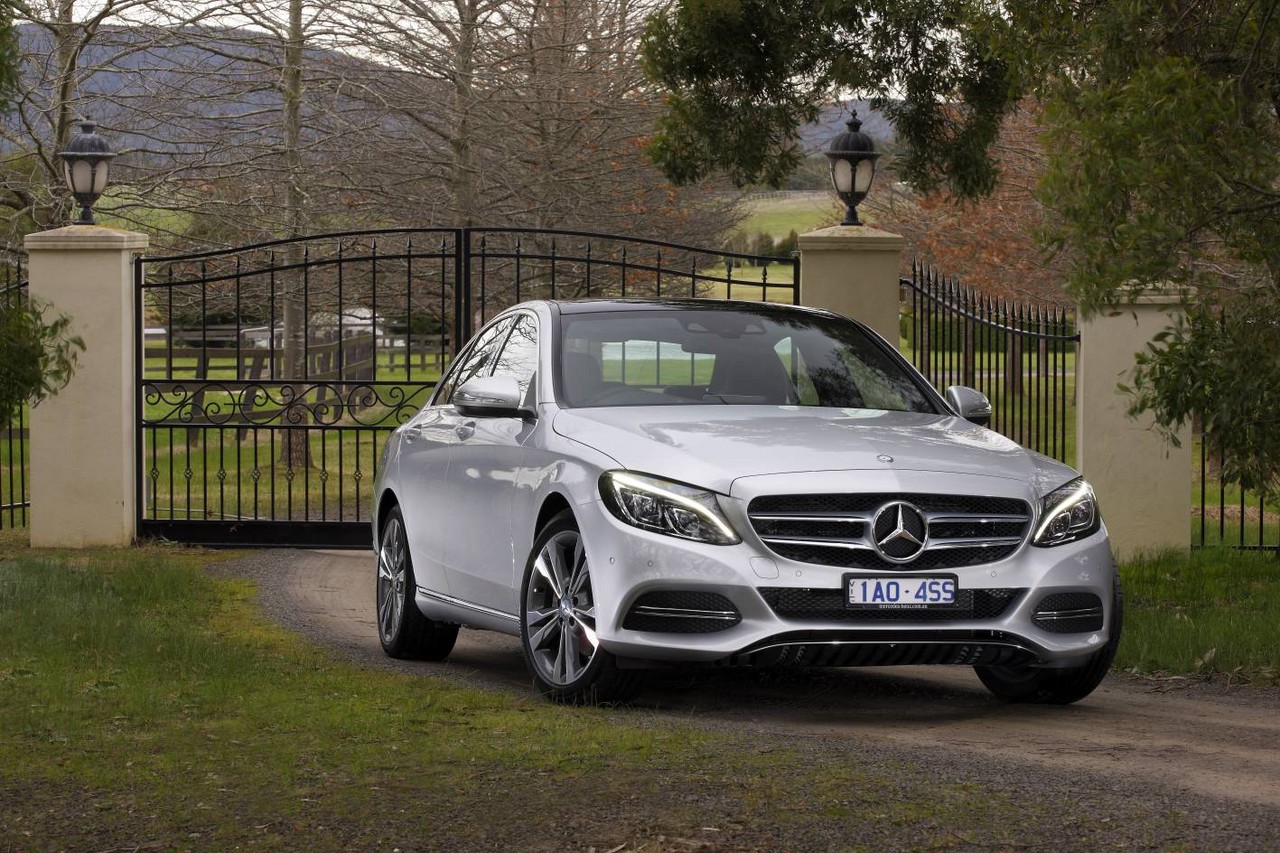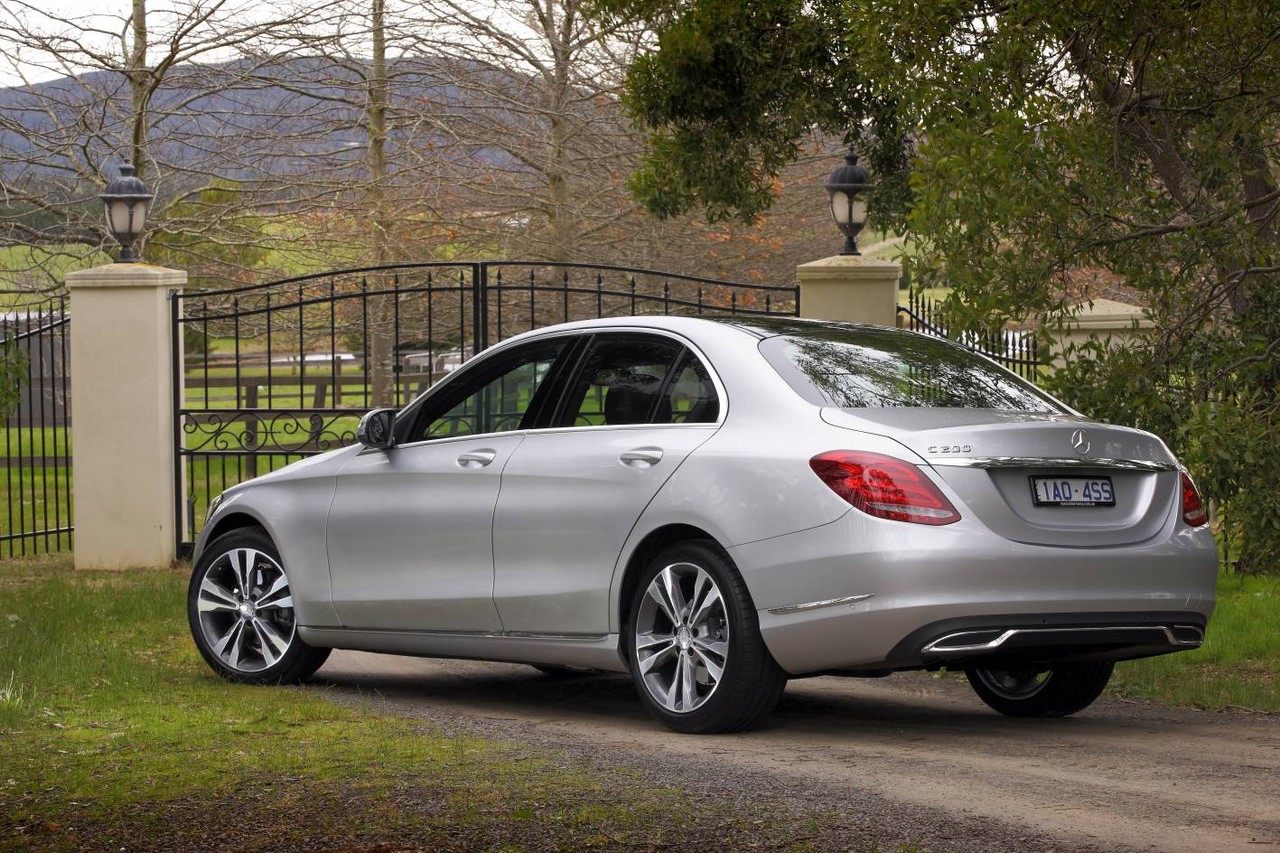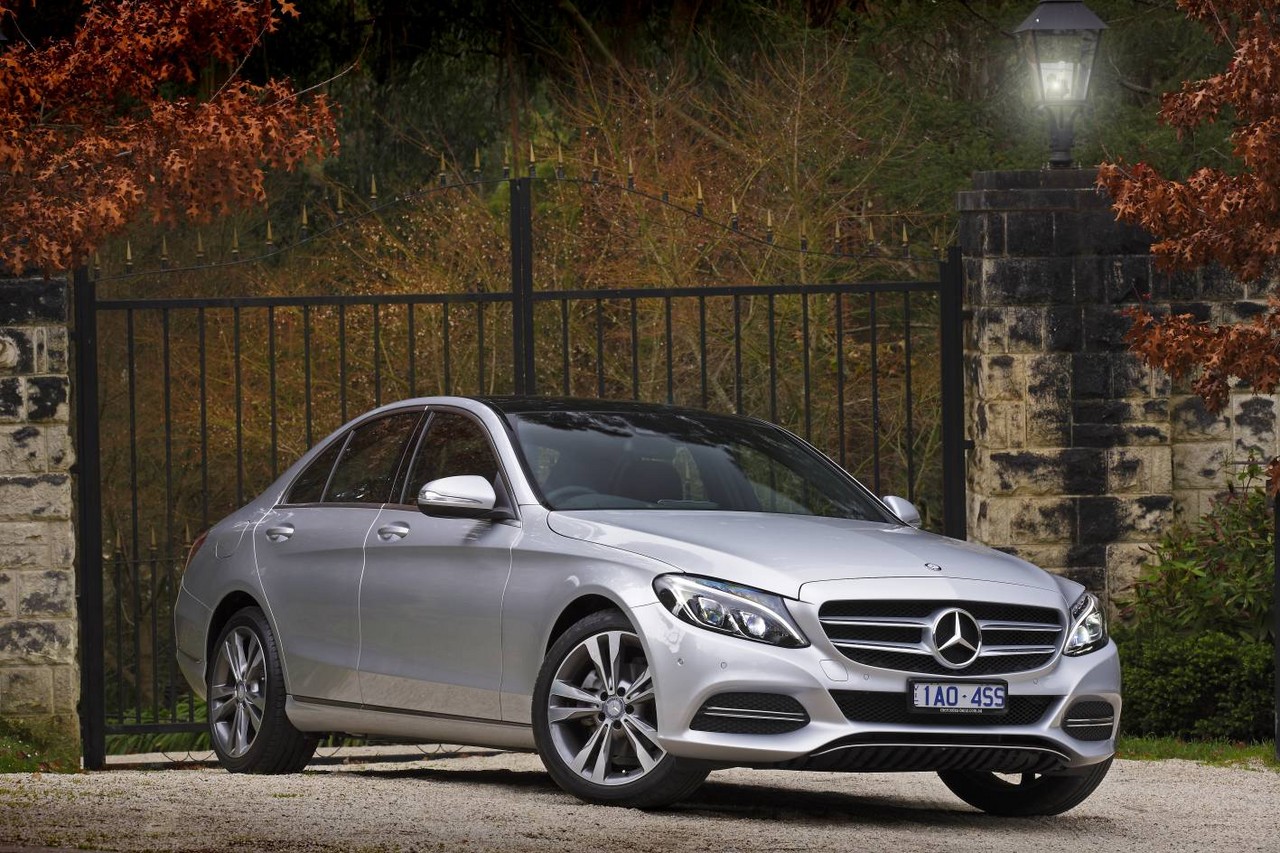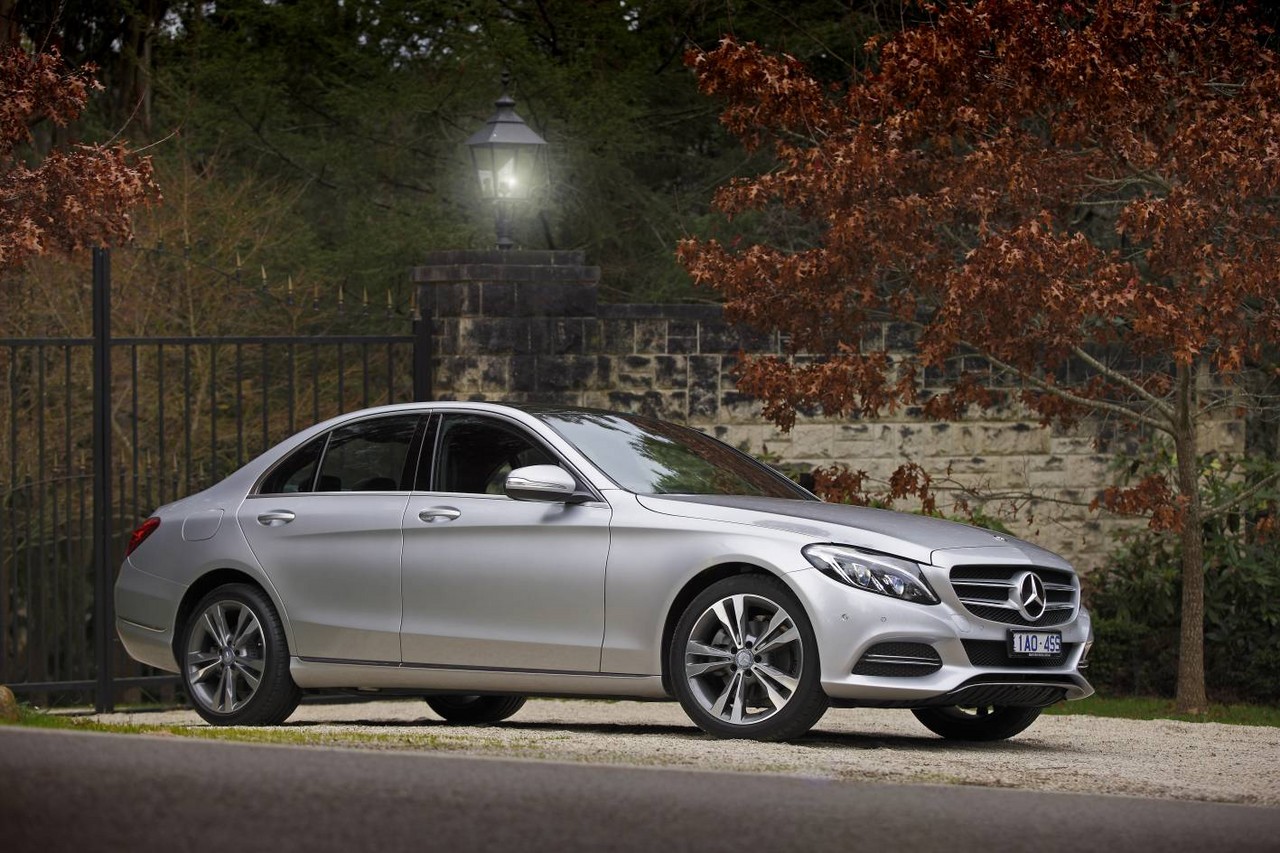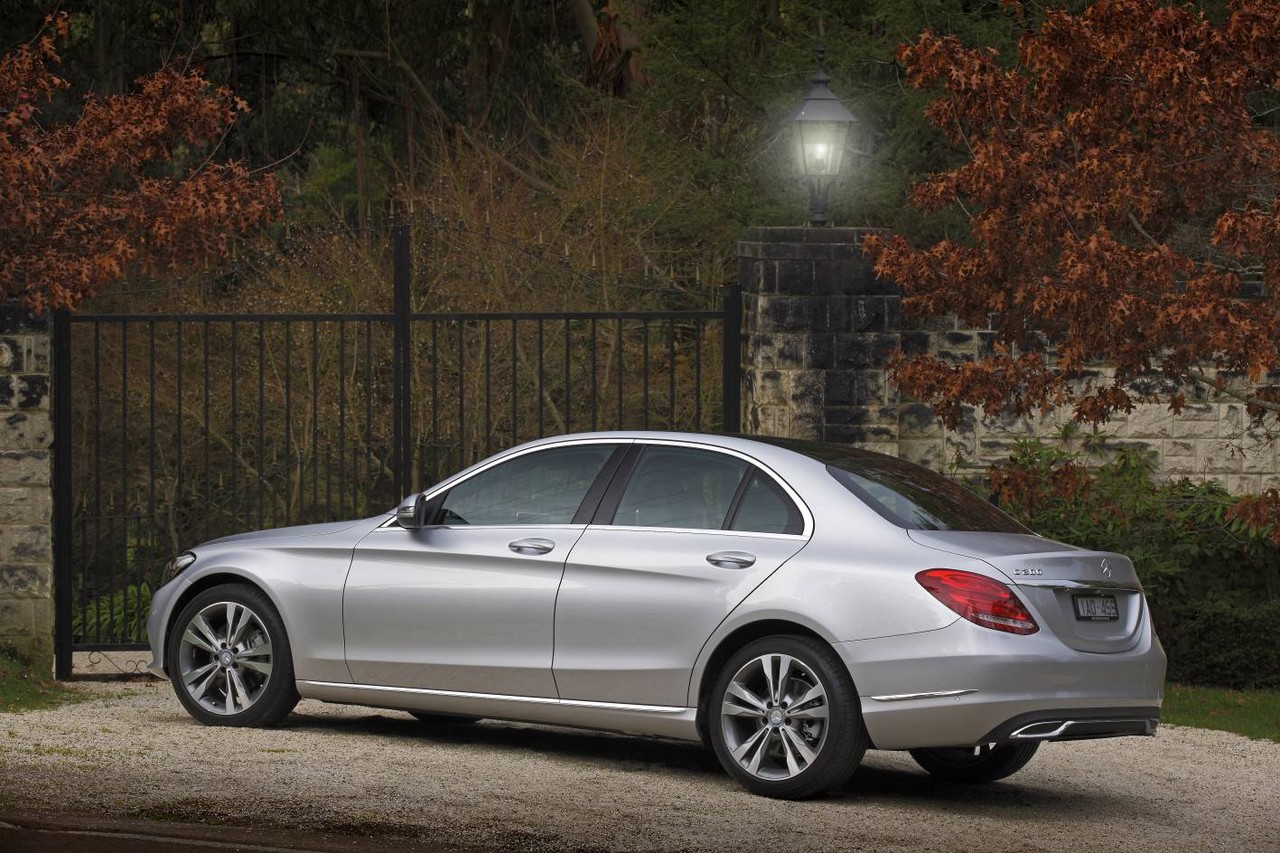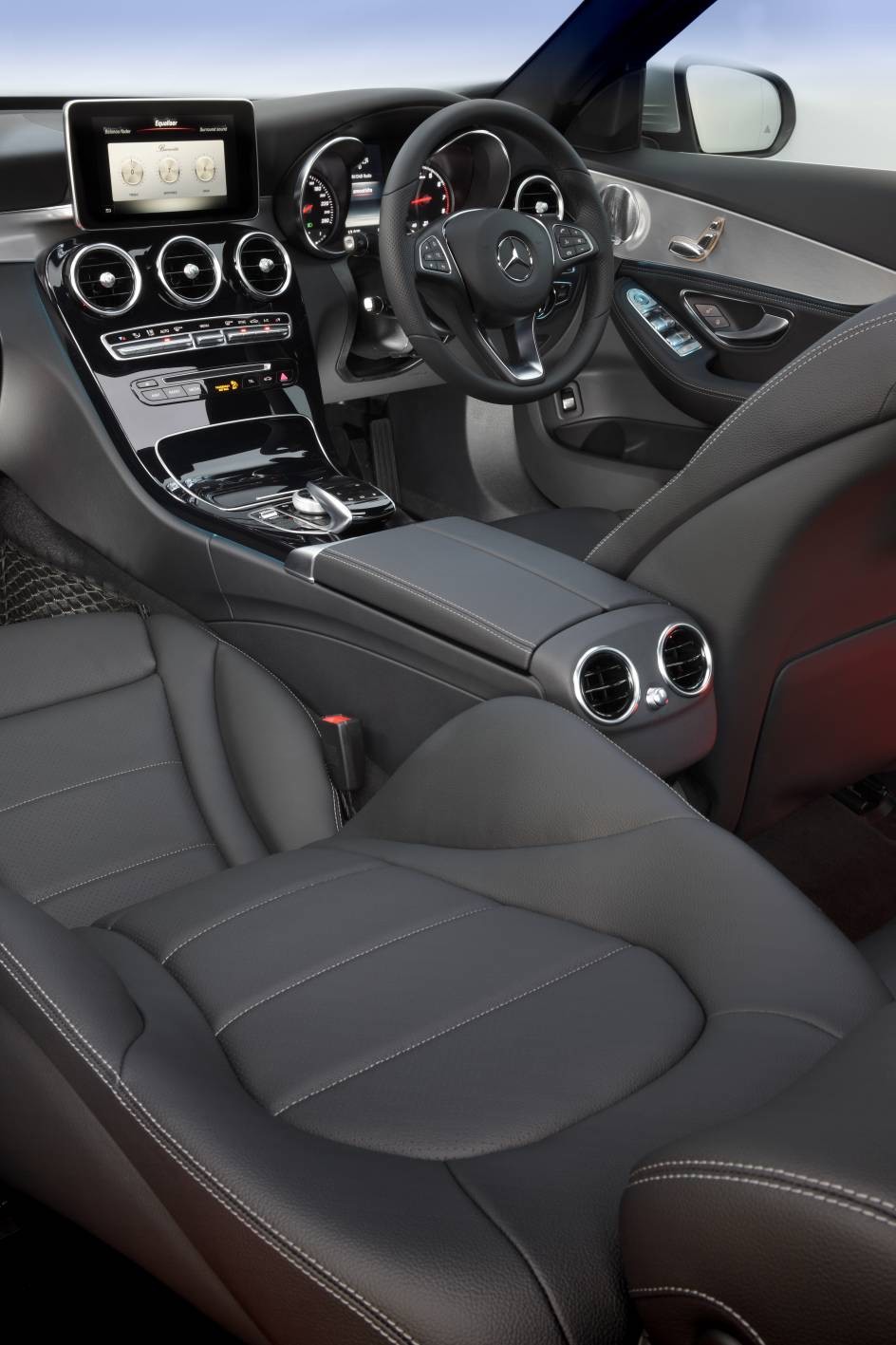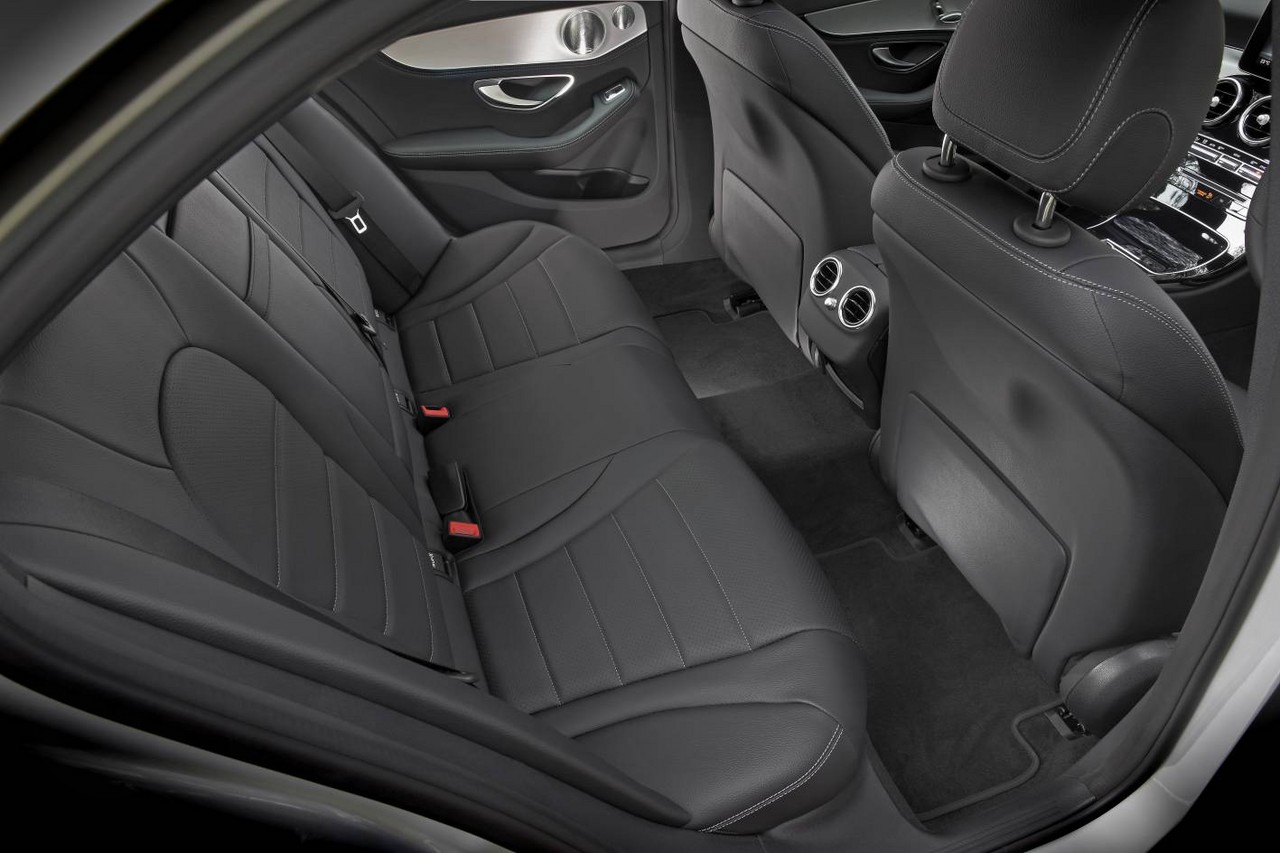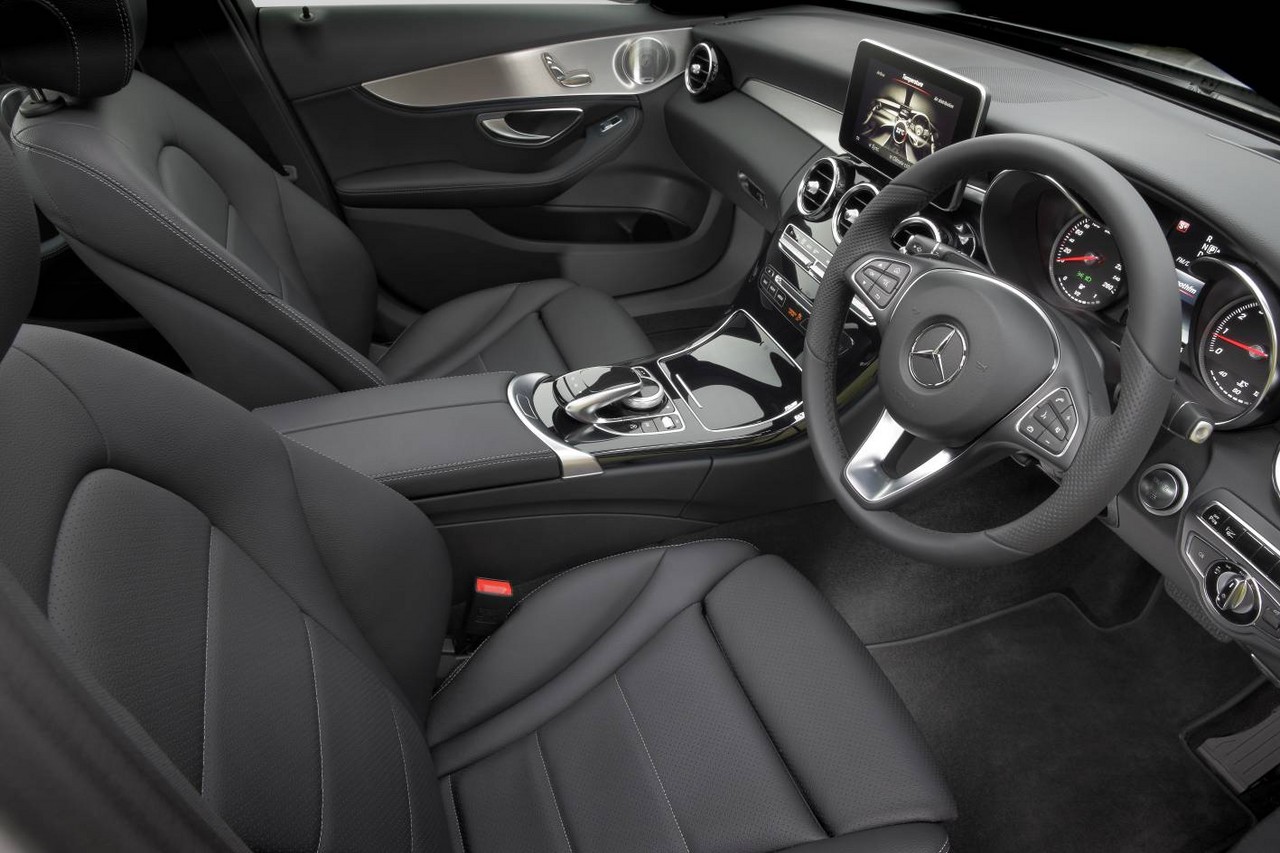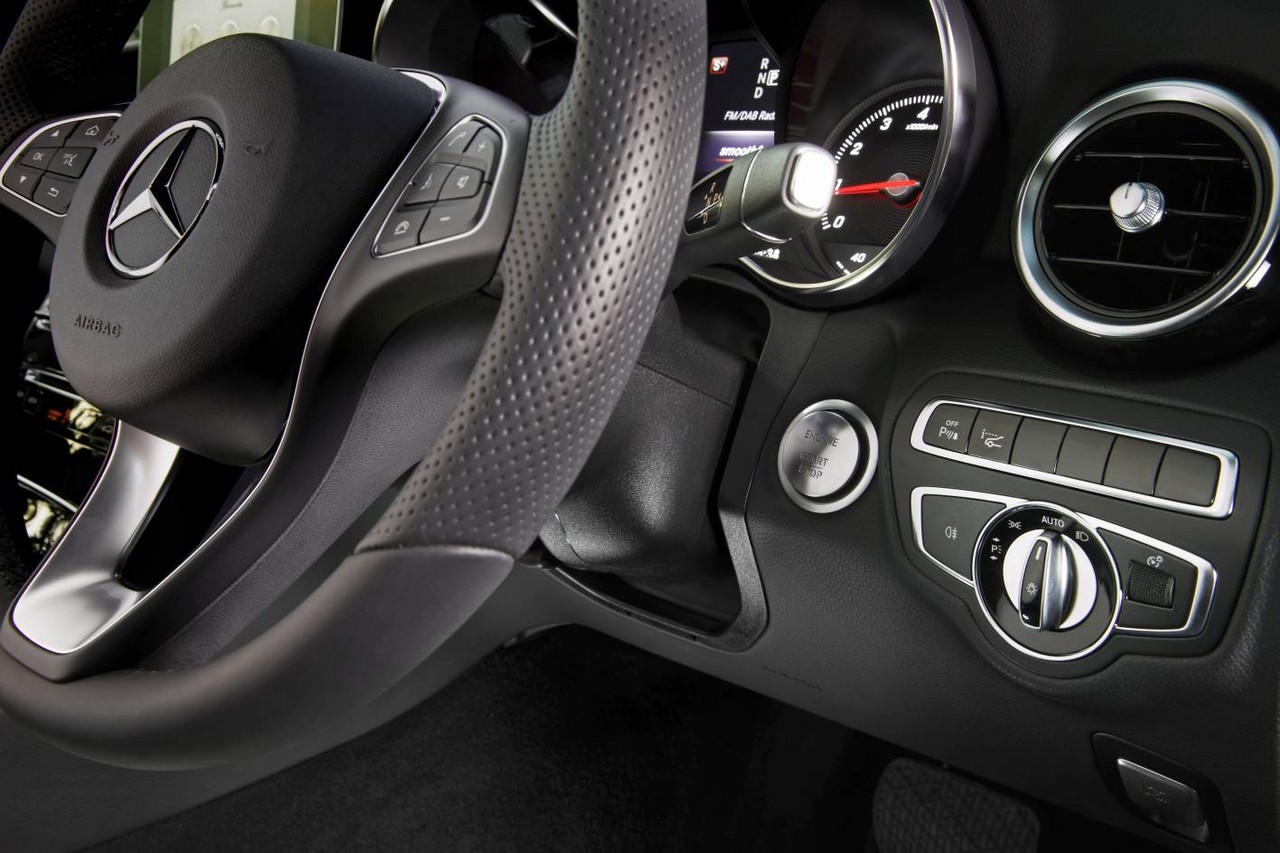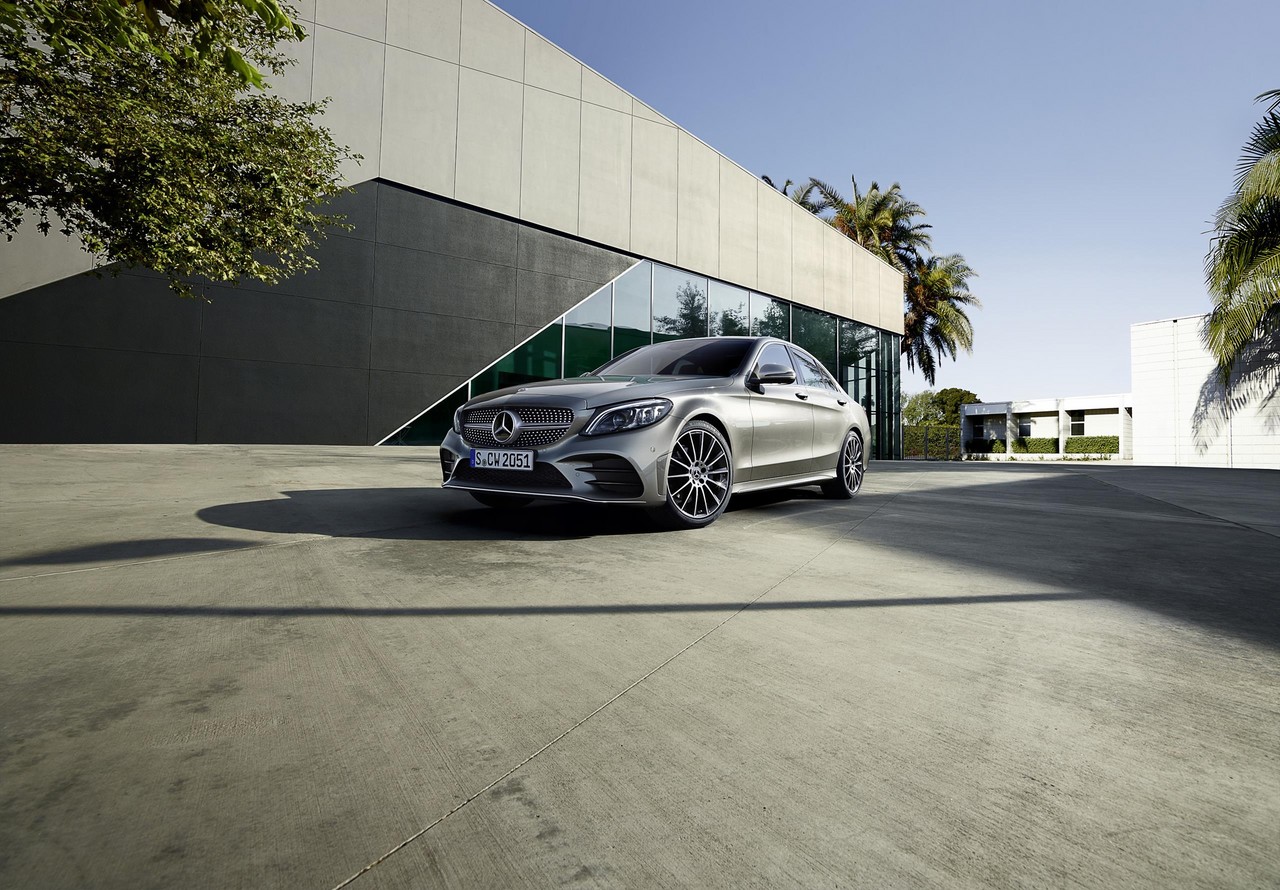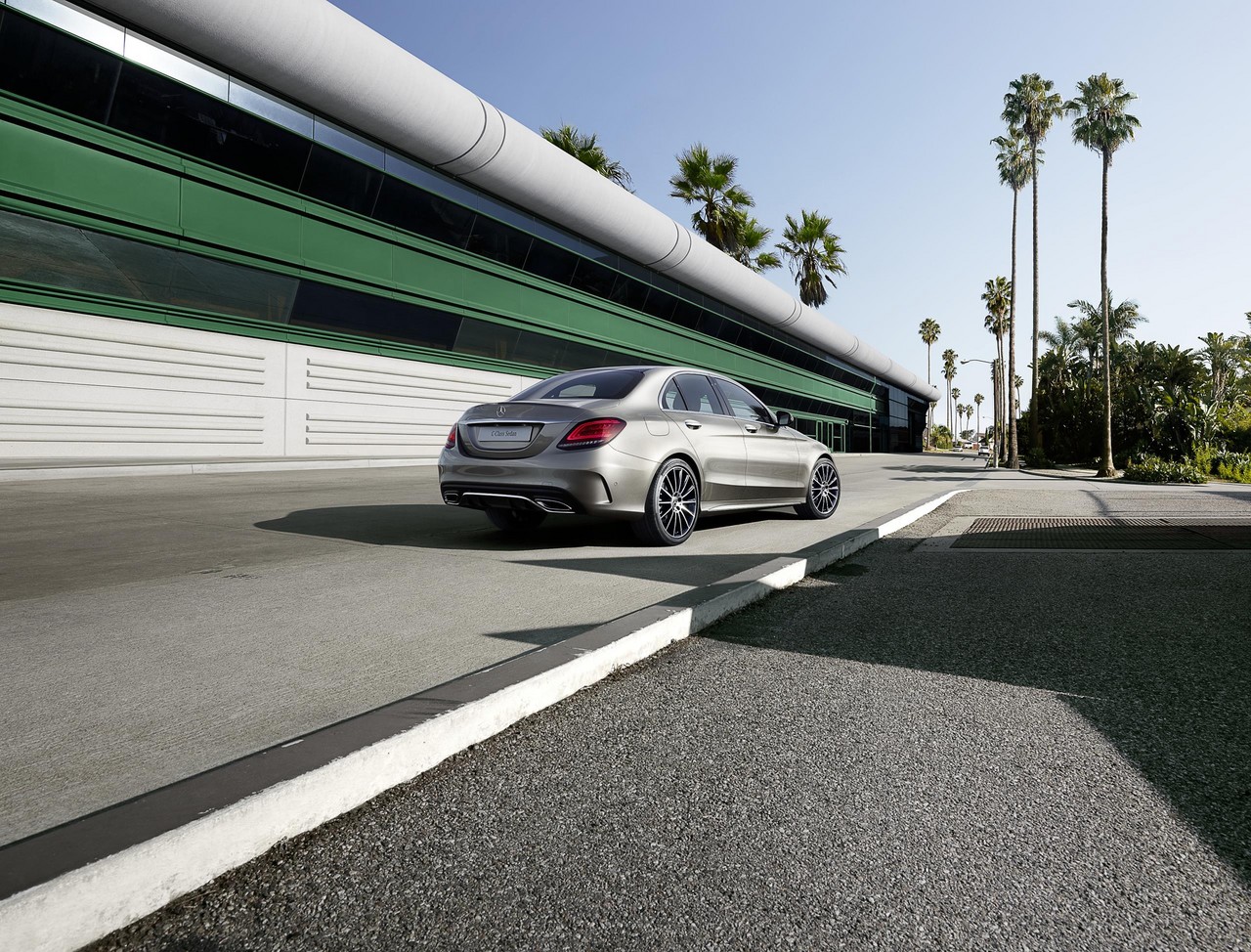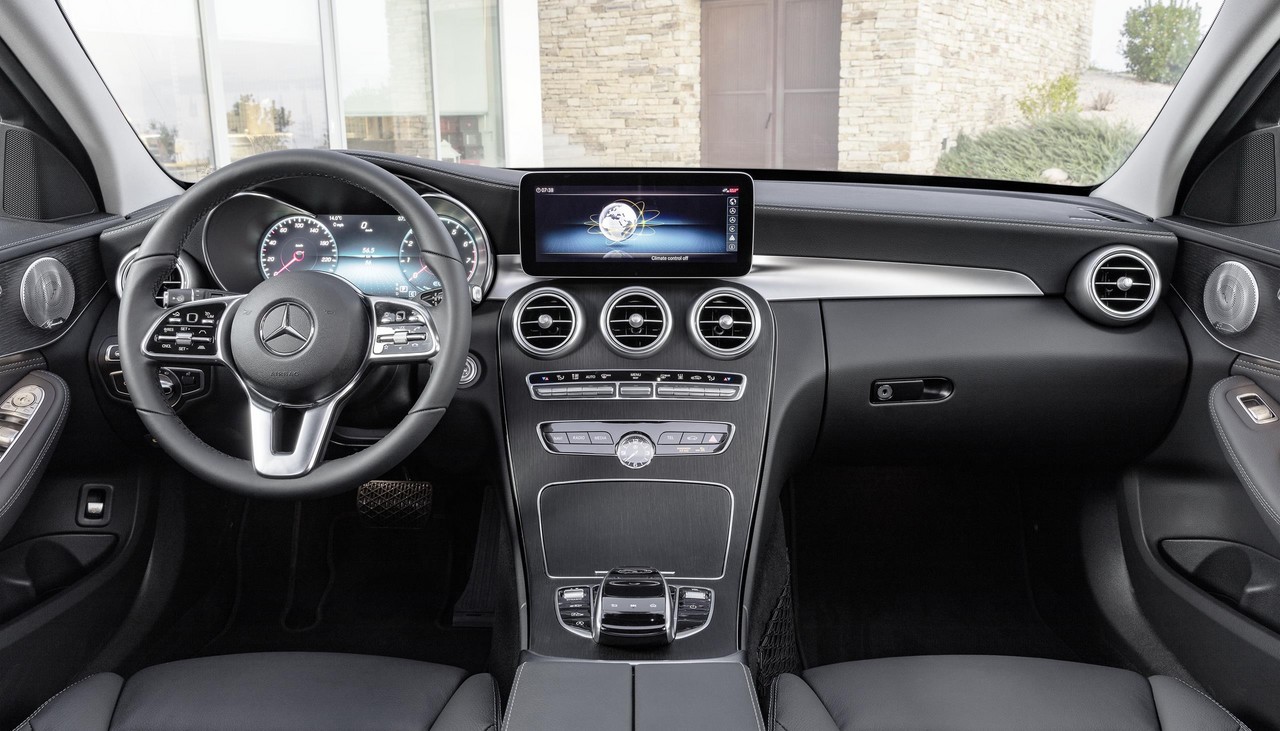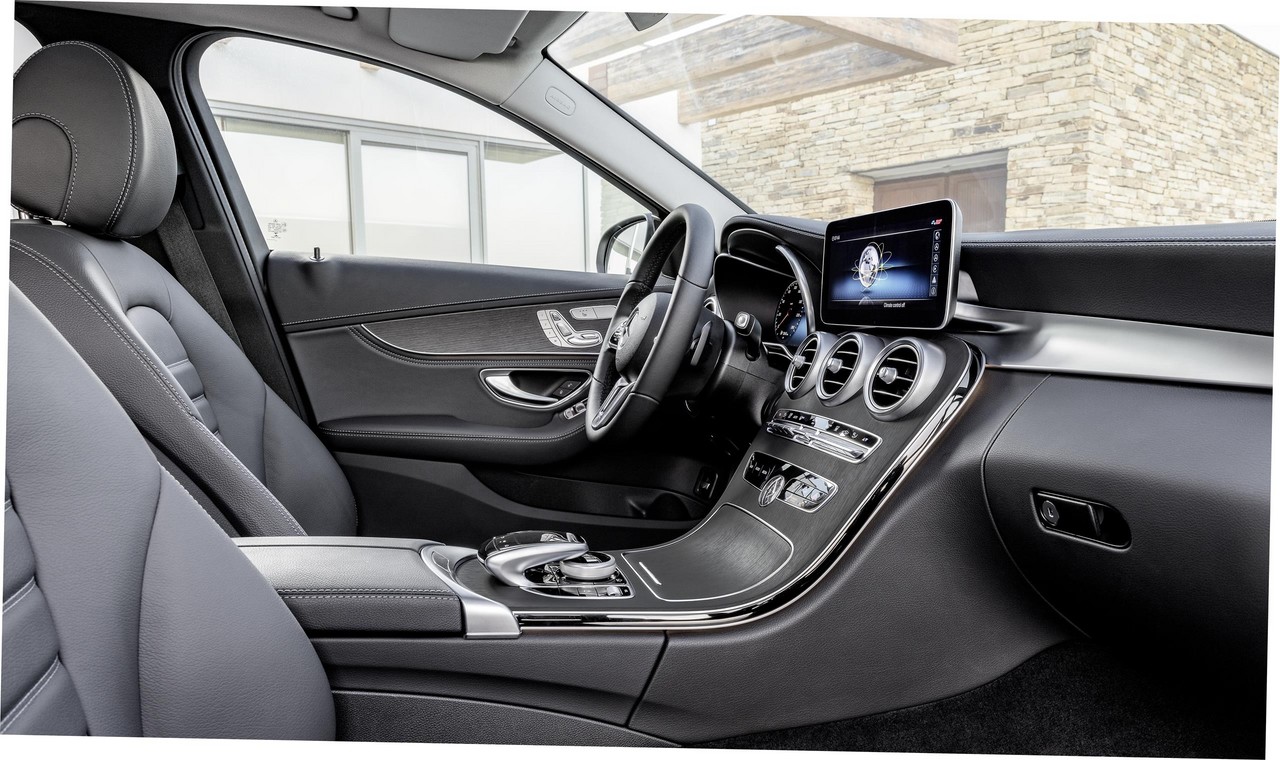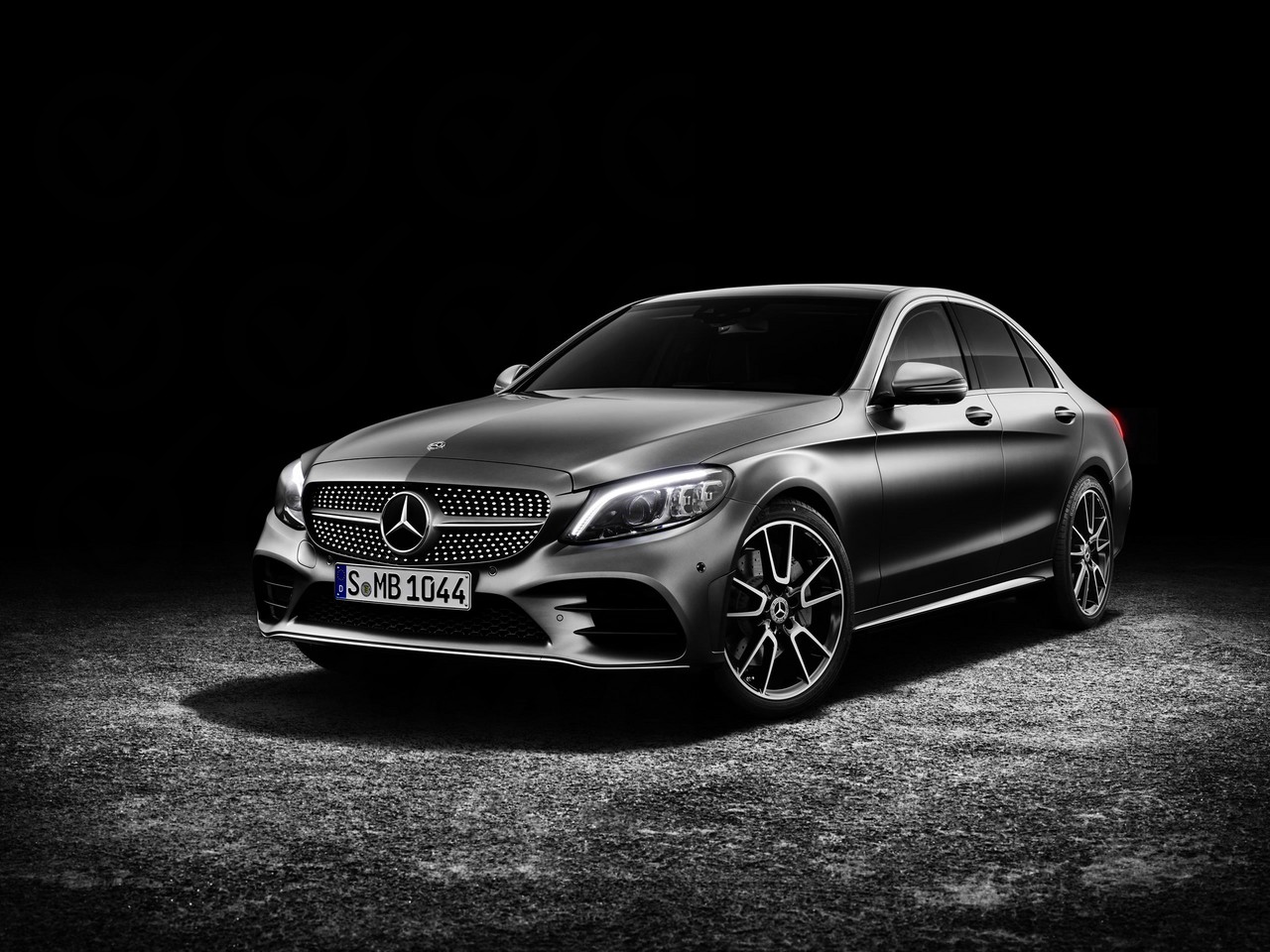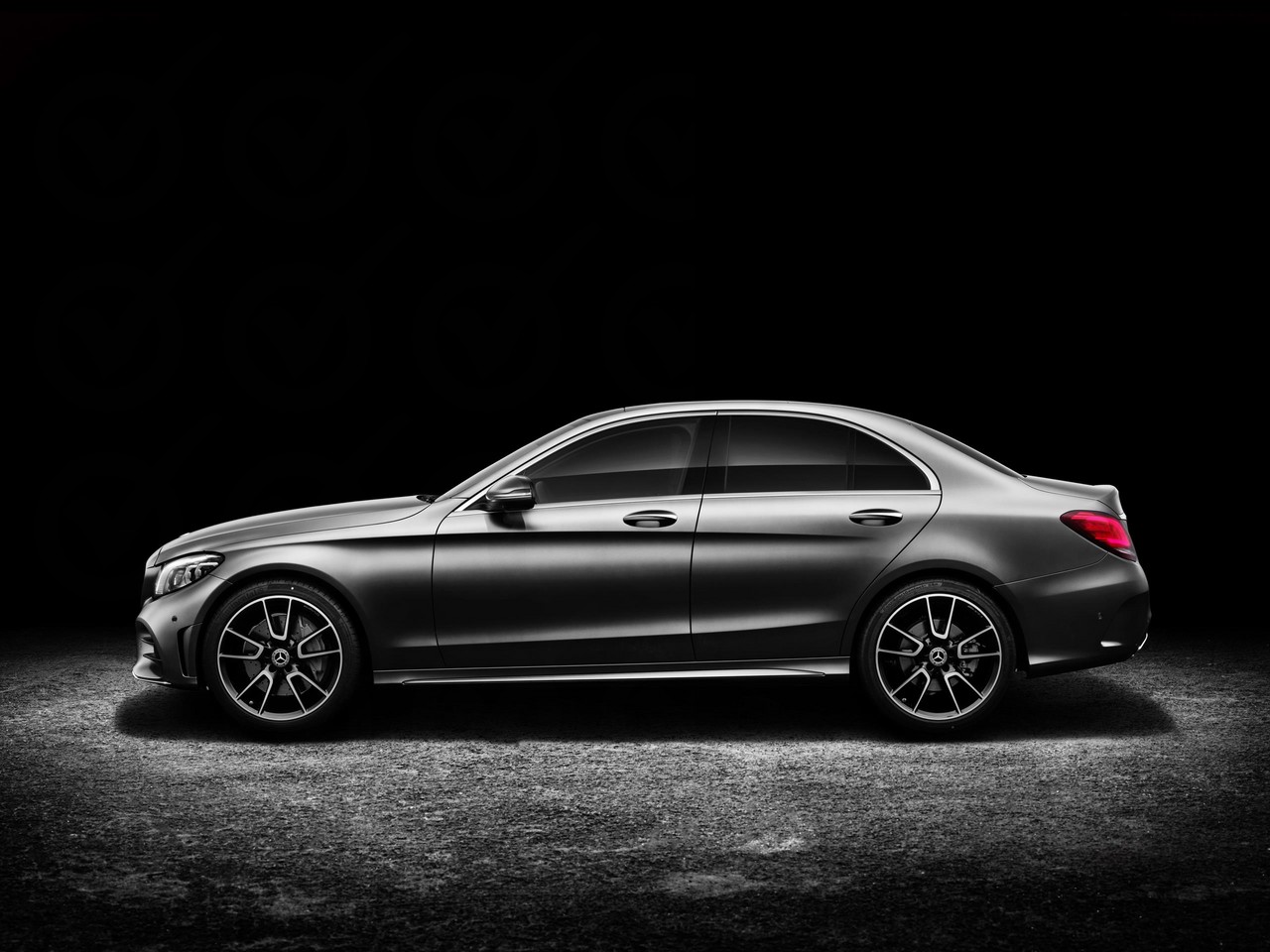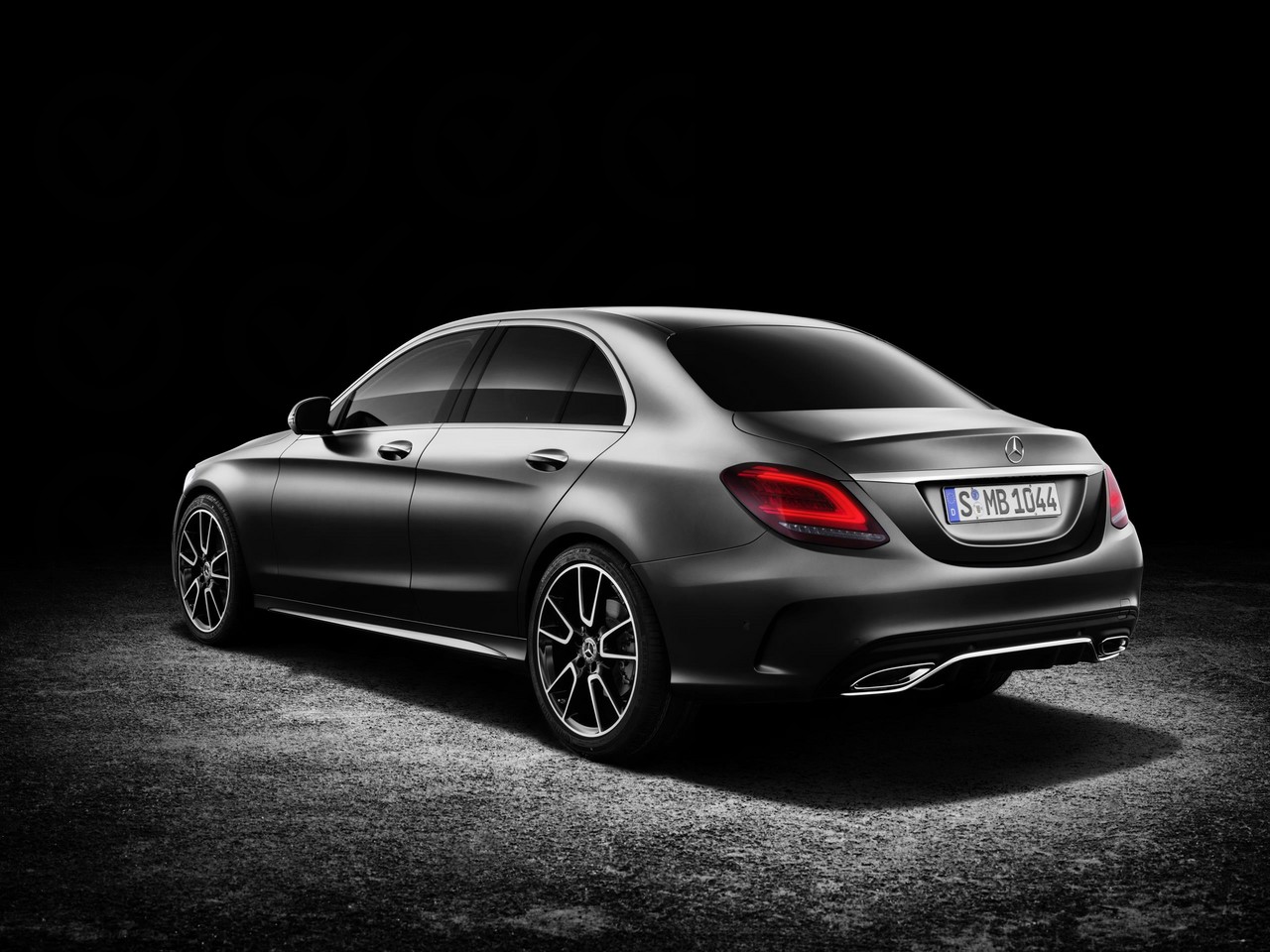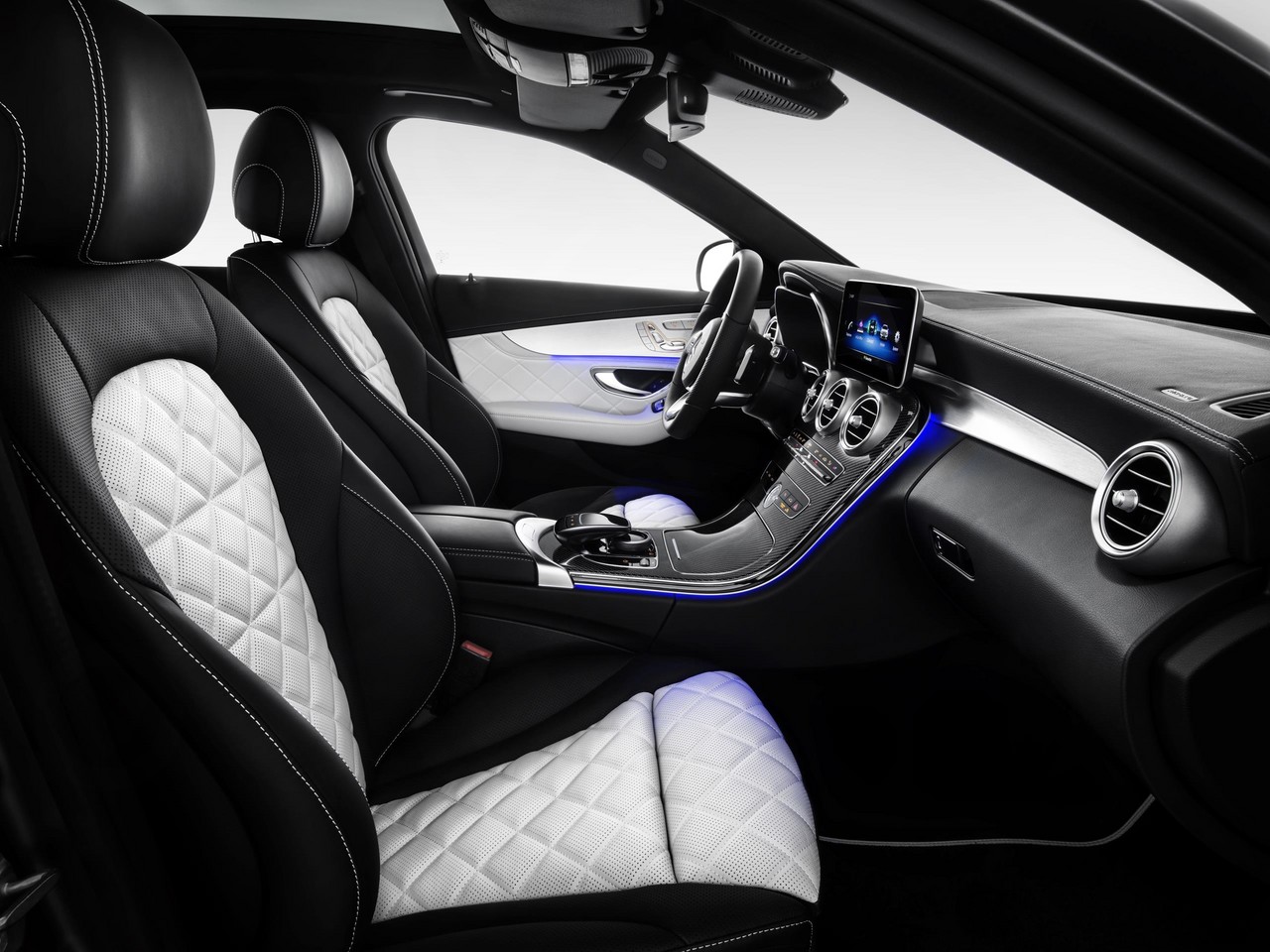
- Responsive turbocharged petrol engines
- Frugal turbo-diesel engines
- Well-weighted steering has good feedback
- High standard of fit and finish
- Accomplished ride/handling balance…
- … but 19-inch alloy wheels hurt ride quality
- Limited rear seat space
- Diesel engine noise at low rpm
Review: Mercedes-Benz W205.I C-Class sedan (2014-18)
Overview
Released in Australia in August 2014, the Mercedes-Benz W205 C-Class was a compact executive sedan. For Australia, the rear-wheel drive W205 C-Class sedan range initially consisted of the C 200, C 250 and C 250 BlueTec, with the C 200 BlueTec and C 300 BlueTec Hybrid following in late 2014. For these models, all C-Class engines featured an ECO start/stop function (i.e. cylinder deactivation when stationary in traffic) to minimise fuel consumption and complied with Euro 6 emissions standards. For Australia, the W205 C-Class was solely available with seven-speed automatic transmissions (Mercedes-Benz’s ‘7G-Tronic Plus’).
The plug-in hybrid C 350 e was released in July 2016 and combined the 2.0-litre M274 petrol engine with a 60 kW electric motor. Over the ADR 81/02 combined test cycle, fuel consumption for the C 350 e was 2.4 litres per 100 km and, according to Mercedes-Benz, the W205 C 350 e had an all-electric range of up to 31 kilometres. In July 2017, the W205 C-Class range was revised as the C 200 d and C 250 were replaced by the C 220 d and C 300, respectively. The full W205 C-Class sedan range is given in the table below; please note that the Mercedes-AMG W205 C 63 has been reviewed separately.
While the initial, launch C-Class vehicles were manufactured in Sindelfingen, Germany, subsequent Australian-delivered vehicles were manufactured at Mercedes-Benz’s plant in Rosslyn, South Africa (with the exception of the German-built C 300 BlueTec).
| Years | Engine | Trans. | Peak power | Peak torque | |
|---|---|---|---|---|---|
| C 200 BlueDirect | 2014-18 | 2.0-litre turbo petrol I4 (M274 DE 20 AL) |
7sp auto | 135 kW at 5500 rpm | 300 Nm at 1200-4000 rpm |
| C 200 BlueTEC / C 200 d |
2014-17 | 1.6-litre turbo-diesel I4 (OM 626 E 16 LA) | 7sp auto | 100 kW at 3800 rpm | 320 Nm at 1500-2600 rpm |
| C 220 d | 2017-18 | 2.1-litre bi-turbo diesel I4 (OM651 DE 22 LA) |
9sp auto | 125 kW at 3000-4200 rpm | 400 Nm at 1400-2800 rpm |
| C 250 BlueDirect | 2014-17 | 2.0-litre turbo petrol I4 (M274 DE 20 AL) |
7sp auto | 155 kW at 5500 rpm | 350 Nm at 1200-4000 rpm |
| C 250 BlueTEC / C 250 d |
2014-18 | 2.1-litre bi-turbo diesel I4 (OM651 DE 22 LA) |
7sp auto | 150 kW at 3800 rpm | 500 Nm at 1600-3800 rpm |
| C 300 | 2017-18 | 2.0-litre turbo petrol I4 (M274 DE 20 AL) |
9sp auto | 180 kW at 5550 rpm | 370 Nm at 1300-4000 rpm |
| C 300 BlueTec Hybrid | 2015 | 2.1-litre bi-turbo diesel I4 (OM651 DE 22 LA) |
7sp auto | 150 kW at 4200 rpm | 500 Nm at 1600-1800 rpm |
| Electric motor | 20 kW | 250 Nm | |||
| C 350 e | 2016-18 | 2.0-litre turbo petrol I4 (M274 DE 20 AL) |
7sp auto | 155 kW at 5500 rpm | 350 Nm at 1200-4000 rpm |
| Electric motor | 60 kW at 2000 rpm | 340 Nm | |||
| Combined | 205 kW at 5000 rpm | 600 Nm | |||
Aluminium hybrid body
The Mercedes-Benz W205 C-Class had a hybrid aluminium/steel body which combined aluminium, hot-formed steel parts and ultra-high strength steels. Furthermore, the use of aluminium for the C-Class’s outer skin – i.e. the front wings, bonnet, boot lid, doors and roof paneling – contributed to a reduction in gross vehicle mass of 100 kg relative to the Mercedes-Benz W204 C-Class . Compared to its predecessor, the W205 C-Class was 95 mm longer (at 4686 mm), 40 mm wider (1810 mm) and had an 80 mm longer wheelbase (2840 mm).
Suspension
The Mercedes-Benz W205 C-Class had four-link front and five-link rear suspension, with all shock absorbers mounted on aluminium die-cast components. The ‘Direct Control’ suspension included variable dampers which adapted to road surface conditions, while the optional ‘Airmatic’ air suspension provided self-levelling and variable ride height functions (in addition to variable damping). For the Airmatic suspension, drivers could select from Comfort, Eco, Sport and Sport Plus drive modes.
Safety equipment
Standard safety equipment for the Mercedes-Benz W205 C-Class included dual front airbags, a driver’s knee airbag, front and rear side airbags, full-length curtain airbags, ABS, electronic brake force distribution, brake assist, electronic stability control, traction control, blind spot monitoring (‘Blind Spot Assist’), a driver fatigue warning, cornering brake control and front seatbelts with pre-tensioners and load limiters. The front passenger seat was also available with a child seat recognition system (replacing the previous transponder unit) which automatically deactivated the front airbag.
As standard, the W205 C-Class was fitted with Mercedes-Benz’s ‘Collision Prevention Assist Plus’. operating at speeds up to 250 km/h to monitor the traffic ahead and at speeds up to 50 km/h for stationary objects, Collision Prevention Assist would issue a visual warning (when driving at speeds over 7 km/h) and an optical warning (when driving at speeds over 30 km/h if there was a collision risk. At speeds below 105 km/h (250 km/h in conjunction with Distronic Plus), Collision Prevention Assist Plus would initially provide partial autonomous braking to reduce vehicle speed and alert the driver. Furthermore, adaptive Brake Assist would calculate the braking force required and prime the braking system for optimum response when the driver depressed the brake pedal. If the driver did not respond and a collision was unavoidable, then maximum braking force would be applied to reduce vehicle speed. At initial vehicle speeds of up to 40 km/h, rear-end collisions could be prevented.
The W205 C 250, C 250 BlueTec and C 300 BlueTec Hybrid were further equipped with:
- Distronic Plus (adaptive cruise control with brake warning): an ‘adaptive’ cruise control system which used two short-range radar sensors positioned behind the front bumper to monitor the road up to 30 metres ahead, and a long-range radar located behind the radiator grille which had a range of 200 metres. Operating at speeds up to 200 km/h, Distronic Plus used an electronic control unit to analyse the information from both radar systems to calculate the engine, automatic transmission and braking parameters required for proximity control. As such, Distronic Plus could automatically apply the brakes to prevent the vehicle from becoming too close to traffic ahead (the time interval could be specified) and accelerate back to the set speed when traffic allowed. To accelerate from rest, the driver only needed to operate the Distronic stalk on the steering column or briefly depress the accelerator pedal. With Distronic Plus, automatic deceleration of up to four (4) m/s2was possible. If Distronic Plus detected that heavier braking was required, a warning light would illuminate in the instrument cluster and be accompanied by an audible warning. Furthermore, the electronic proximity control system could be activated independently of Distronic Plus at speeds over 30 km/h to alert the driver if they were approaching another vehicle too rapidly;
- Steering Assist with Stop&Go Pilot: operating in conjunction with Distronic Plus and at speeds up to 130 km/h, Steering Assist used a stereo camera located behind the windscreen to detect road markings, while the Stop&Go Pilot operated at speeds up to 60 km/h and enabled the system to use the vehicle in front or road markings as a means of orientation. If the vehicle was detected to be drifting out of its lane, Steering Assist would warn the driver and provide steering intervention to keep the vehicle in its lane;
- Pre-Safe Brake with pedestrian detection (autonomous emergency braking): using two 24 GHz sensors behind the front bumper which had a range of 30 metres and a 77 GHz radar which had a range of 200 metres, Pre-Safe Brake operated at speeds between 30 km/h and 200 km/h, and at speeds below 70 km/h if the vehicle was approaching a stationary queue of traffic. Around 2.6 seconds before the anticipated moment of impact, an audible warning would sound and a red warning would appear in the tachometer. Around 1.6 before the calculated impact, the first stage of Pre-Safe Brake would initiate partial braking autonomously with around 40 per cent of the maximum braking power (approximately four (4) m/s2); the Pre-Safe occupant protections system would also be activated. If the driver then applied the brakes, maximum braking force would be made available. If the driver failed to react, Pre-Safe Brake would – in its second stage – initiate autonomous emergency braking (i.e. maximum braking power) around 0.6 seconds before the unavoidable collision to reduce the severity of the impact. The pedestrian recognition function enabled Pre-Safe Brake to detect pedestrians when driving at speeds of up to 50 km/h;
- Pre-Safe Plus: could anticipate rear-end collisions and warn following traffic by activating the rear hazard lights at high frequency. The Pre-Safe system would then deploy occupant protection measures and apply the vehicle’s brakes to prevent secondary accidents;
- BAS Plus with Cross-Traffic Assist: used a 24 GHz radar sensor with a range of 30 metres and a 77 GHz radar sensor with a range of 200 metres to monitor the distance to the vehicle ahead and would warn the driver if there was a risk of a collision. Brake Assist Plus could detect vehicles when travelling at speeds up to 200 km/h, and stationary objects when the driver was travelling at 7 km/h to 72 km/h. Significantly, Brake Assist Plus could calculate the necessary brake force assistance to prevent a rear-end collision, build up that pressure in the braking system and provide it as soon as the brake pedal was depressed for ‘the best possible deceleration’. The Cross-Traffic Assist function could operate at speeds up to 72 km/h and used the stereo camera and radar sensors to detect traffic that was crossing in front of or behind the vehicle. If detected, the driver would receive visual and audible alerts;
- Active Blind Spot Assist: an extension of Blind Sport Assist, Active Blind Spot Assist could apply the brakes on one side of the vehicle to counter-act a driver’s attempt to change lanes when it was not safe to do so; and,
- Active Lane Keeping Assist: could detect when the adjacent lane was occupied (including oncoming traffic) and prevent the driver from inadvertently exiting from the lane when it was not safe to do so by applying a corrective braking force to the wheels on one side of the vehicle.
Euro NCAP testing
In Euro NCAP testing , the Mercedes-Benz W205 C-Class received a five star safety rating which included a 92 per cent adult occupant protection rating and an 84 per cent child occupant protection rating. In the offset crash test, protection of the front occupants was generally rated as good, though lower leg protection for both the driver and passenger was rated as adequate (i.e. a slight risk of serious injury). In the side impact test, driver protection was rated as good in all areas; in the more severe pole test, however, chest protection was rated as marginal and abdomen protection as adequate.
Features: Mercedes-Benz W205 C-Class
Standard features for the Mercedes-Benz W205 C 200 and C 200 BlueTEC included 18-inch alloy wheels, an ‘Audio 20’ sound system with five speakers, DAB+ digital radio, a CD player, MP3/WMA/AAC compatibility, auxiliary inputs (3.5 mm/USB/iPod), Bluetooth mobile phone connectivity and audio streaming, a seven-inch TFT colour display with Garmin ‘Map Pilot’ navigation, dual-zone climate control air conditioning, ‘Artico’ synthetic leather upholstery, four-way power adjustable front seats, cruise control, LED headlights and daytime running lights, automatic headlights, rain-sensing wipers, front and rear parking sensors, a reversing camera with dynamic guidelines, a nappa leather steering wheel with gearshift paddles, 40:20:40 folding rear seats, remote central locking, power windows, power adjustable and heated mirrors with folding function, tilt and telescopic steering wheel adjustment, push-button start, ambient lighting, illuminated vanity mirrors, an auto-dimming rear view mirror, 12 volt power socket, a trip computer and an immobiliser.
As standard, the W205 C-Class was also fitted with Active Parking Assist which provided automated steering and braking for parking in parallel and perpendicular spaces.
The C 250, C 250 BlueTEC and C 300 BlueTEC Hybrid were further equipped with 19-inch ten-spoke alloy wheels, leather upholstery, a proximity key for keyless entry, rear privacy glass and automatic powered boot closing.
July 2017 update: Exclusive Line Package
From July 2017, all Mercedes-Benz W205 C-Class Sedan models other than the C 350 e could be specified with an ‘Exclusive Line’ package as a no-cost option. The Exclusive Line package included 18-inch five-twin-spoke alloy wheels, ‘Agility Control’ suspension, ‘Artico’ synthetic leather dashboard and beltline trim, and brown ash open pore wood and silver chrome interior trim. For the C 200 and C 220 d, the Exclusive Line package also included ‘Artico’ synthetic leather upholstery and Mercedes-Benz’s ‘Airpanel’ radiator grille which had an adaptive closing function; for the C 250 d and C 300, however, the Exclusive Line package included leather upholstery.
2018 Mercedes-Benz W205 C 200 Edition C
The Mercedes-Benz W205 C 200 Edition C could be ordered during April and May 2018. Compared to the standard Mercedes-Benz W205 C 200, the ‘Edition C’ package added 19-inch five twin-spoke alloy wheels, smartphone integration (via Apple CarPlay or Android Auto), a power-operated glass sunroof and a choice of metallic paint finishes. The Mercedes-Benz W205 C 200 Edition C had a drive-away price of $60,900.
Brochure
Specifications
- Specifications: Mercedes-Benz W205 C-Class Sedan (August 2014)
- Specifications: Mercedes-Benz W205 C-Class Sedan (July 2017)
Related links
Review: Mercedes-Benz W205.II C-Class sedan (2018-20)
Overview
Released in Australia in August 2018, the Mercedes-Benz W205.II C-Class sedan introduced a revised range that initially consisted of C 200 EQ Boost and C 220 d models, with the C 300 following in October 2018.
The W205.II C-Class introduced a new ‘electronic architecture’. For the C 200 EQ Boost, this electronic architecture enabled it to have an additional 48 volt onboard network and a belt-driven starter/alternator for fast restarts and low vibrations. Furthermore, ‘EQ Boost’ provided the following functions:
- When accelerating, EQ Boost could assist the engine with an additional 10 kW until the turbocharger accumulated full charge pressure;
- The EQ Boost function would also assist the engine to reach its ideal operating speed as quickly as possible during gearshifts to reduce shift times;
- During deceleration, the starter/alternator would recuperate kinetic energy and charges the battery;
- The water pump was electrically driven and actuated by a characteristic map to adapt cooling output according to need; and,
- Below a certain speed, a ‘glide mode’ would decouple the engine from the drivetrain to avoid engine braking and the engine would switch off to reduce fuel consumption.
Visually, the Mercedes-Benz W205.II C-Class sedan could be identified by its redesigned front bumper, while the front and rear lamps were ‘defined by clear-lined contours’.
| Engine | Trans. | Peak power | Peak torque | |
|---|---|---|---|---|
| C 200 EQ Boost | 1497 cc M264 turbo petrol I4 | 9sp auto | 135 kW at 5800-6100 rpm, plus 10 kW EQ Boost | 280 Nm at 3000-4000 rpm |
| C 220 d | 1950 cc OM654 turbo diesel I4 | 9sp auto | 143 kW at 3800 rpm | 400 Nm at 1600-2800 rpm |
| C 300 | 1991 cc M264 turbo petrol I4 | 9sp auto | 190 kW at 5500 rpm | 370 Nm at 1800-4000 rpm |
Safety equipment
The Mercedes-Benz W205.II C-Class introduced improved camera and radar systems. For example,
- The forward-facing camera had a maximum range of 500 metres, including 90 metres in 3D; and,
- The vehicle’s surroundings would be scanned by radar across a distance of up to 250 metres to the front, 40 metres to the sides and 80 metres to the rear.
For the W205.II C-Class, ‘Collision Prevention Assist Plus’ was effectively renamed ‘Active Brake Assist’.
Features: C 200 EQ Boost, C 220 d and C 300 Sedan
For Australian-delivered Mercedes-Benz W205.II C-Class vehicles, standard features were extended to include:
- A 12.3-inch (1920 x 720 pixel) fully digital instrument display;
- A 10.25-inch (1920 x 720 pixel) central display for the Audio 20 infotainment system (previously seven-inch);
- An SD card navigation system (replacing the Garmin Map Pilot navigation system);
- Apple CarPlay and Android Auto smartphone integration; and,
- Touch-sensitive steering wheel controls.
For a complete list of features for the Mercedes-Benz W205.II C 200 EQ Boost, C 220 d and C 300, please refer to ‘Specifications’, below.
Specifications
Related links
- Mercedes-Benz Australia: Mercedes-Benz C-Class Sedan
- Wikipedia.org: Mercedes-Benz W205 C-Class Sedan
